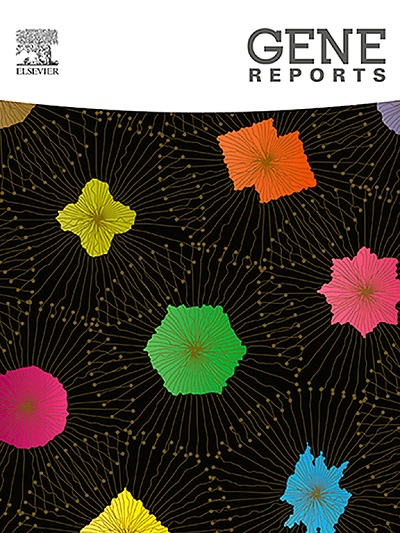Exome sequencing and molecular dynamics simulation characterizes a compound heterozygous GCDH missense variant leading to glutaric aciduria type 1 in a paediatric patient from Jammu and Kashmir, India
IF 1
Q4 GENETICS & HEREDITY
引用次数: 0
Abstract
Glutaric Aciduria Type 1 (GA1) is a rare autosomal recessive metabolic disorder caused by mutations in the gene GCDH, leading to deficiency of the enzyme glutarylCoA dehydrogenase. This study reports a case of GA1 in a 3-year-old male from Jammu and Kashmir, India, presenting with a compound heterozygous mutation in the GCDH. Whole exome sequencing (WES) and molecular dynamics simulations were employed to investigate the genetic and structural basis of GA1 in the proband. Clinical evaluation, MRI, and tandem mass spectrometry were conducted to assess the patient's metabolic profile and neurological status. The pathogenic impact of the identified mutations (c.881G > A; p.Arg294Gln and c.481C > T; p.Arg161Trp) was analyzed using computational tools and molecular dynamics simulations. Molecular dynamics simulations indicated significant dynamic changes in the mutant protein structures. The R161W mutation increased flexibility, while the R294Q mutation caused notable conformational instability at the catalytic site, reducing its normal protein function and stability. The RMSD, RMSF, and SASA analyses supported these findings, correlating well with experimental observations. The molecular dynamics simulations provided valuable insights into the structural implications of the R161W and R294Q mutations and might contribute to a deeper understanding of GA1 molecular mechanisms.
外显子组测序和分子动力学模拟描述了印度查谟和克什米尔一名儿科患者体内导致戊二酸尿症 1 型的复合杂合子 GCDH 错义变体的特征
戊二酸尿症 1 型(GA1)是一种罕见的常染色体隐性遗传代谢性疾病,由 GCDH 基因突变引起,导致戊二酰辅酶脱氢酶缺乏。本研究报告了一例来自印度查谟和克什米尔的 3 岁男性 GA1 患者,他的 GCDH 基因出现了复合杂合突变。研究人员利用全外显子组测序(WES)和分子动力学模拟研究了该病例中 GA1 的遗传和结构基础。临床评估、核磁共振成像(MRI)和串联质谱分析评估了患者的代谢概况和神经系统状况。利用计算工具和分子动力学模拟分析了已确定突变(c.881G > A; p.Arg294Gln和c.481C > T; p.Arg161Trp)的致病影响。分子动力学模拟表明,突变体蛋白质结构发生了显著的动态变化。R161W 突变增加了灵活性,而 R294Q 突变则导致催化位点构象明显不稳定,降低了蛋白质的正常功能和稳定性。RMSD、RMSF 和 SASA 分析支持这些发现,并与实验观察结果密切相关。分子动力学模拟对 R161W 和 R294Q 突变的结构影响提供了有价值的见解,可能有助于加深对 GA1 分子机制的理解。
本文章由计算机程序翻译,如有差异,请以英文原文为准。
求助全文
约1分钟内获得全文
求助全文
来源期刊

Gene Reports
Biochemistry, Genetics and Molecular Biology-Genetics
CiteScore
3.30
自引率
7.70%
发文量
246
审稿时长
49 days
期刊介绍:
Gene Reports publishes papers that focus on the regulation, expression, function and evolution of genes in all biological contexts, including all prokaryotic and eukaryotic organisms, as well as viruses. Gene Reports strives to be a very diverse journal and topics in all fields will be considered for publication. Although not limited to the following, some general topics include: DNA Organization, Replication & Evolution -Focus on genomic DNA (chromosomal organization, comparative genomics, DNA replication, DNA repair, mobile DNA, mitochondrial DNA, chloroplast DNA). Expression & Function - Focus on functional RNAs (microRNAs, tRNAs, rRNAs, mRNA splicing, alternative polyadenylation) Regulation - Focus on processes that mediate gene-read out (epigenetics, chromatin, histone code, transcription, translation, protein degradation). Cell Signaling - Focus on mechanisms that control information flow into the nucleus to control gene expression (kinase and phosphatase pathways controlled by extra-cellular ligands, Wnt, Notch, TGFbeta/BMPs, FGFs, IGFs etc.) Profiling of gene expression and genetic variation - Focus on high throughput approaches (e.g., DeepSeq, ChIP-Seq, Affymetrix microarrays, proteomics) that define gene regulatory circuitry, molecular pathways and protein/protein networks. Genetics - Focus on development in model organisms (e.g., mouse, frog, fruit fly, worm), human genetic variation, population genetics, as well as agricultural and veterinary genetics. Molecular Pathology & Regenerative Medicine - Focus on the deregulation of molecular processes in human diseases and mechanisms supporting regeneration of tissues through pluripotent or multipotent stem cells.
 求助内容:
求助内容: 应助结果提醒方式:
应助结果提醒方式:


